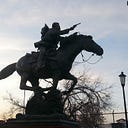The Vision of Francisco Madero
Many groups of people in Mexico in 1910 had a bone to pick with their “elected” leader, Porfirio Diaz. While groups of laborers already thought that Diaz was selling the people of Mexico out to foreign businesses, the real injustice was felt by Mexico’s peasants. They had lost their land where they had traditionally grown food such as corn and beans to large estates that grew cash crops such as sugar cane and cotton. Because you can’t eat cotton, the people in rural Mexico were starving. When people cannot fill a basic need such as where their next meal is coming from, you have the makings of a rebellion.
This rebellion against Diaz leads us to Francisco Madero. When Diaz was forced to make some reforms to the government, an election took place between Diaz and Madero. Madero had the support of the upper and middle class and the Partido Liberal Mexicano. He promised a democracy without messing up the economy or the social order and that promise became very appealing to the upper and middles classes so it was a bit surprising (or not at all, considering Diaz) that Madero only received a couple of hundred votes compared to Diaz’ one million. Madero was arrested and put in prison.
When Madero was released from prison, he made his way to Texas where his new vision came into play. His vision was called The Plan of San Luis Potosi and it was a plan to connect the people of Mexico together in an attempt to remove Diaz from leadership. This time, Madero’s vision included a plan for the peasants and working class as well as the upper and middle classes. The plan called for the return of land to their former owners as well as claiming temporary presidency and a call to take up arms against the current government. With many allies and characters of various temperament, Diaz was brought down and the people of Mexico City celebrated Madero’s victory.
Not all were happy with the new leadership. The people of rural Mexico were still hungry and they felt no relief of their pain. There were also multiple clashes even after the peace treaty was signed because the people didn’t see meaningful change fast enough. Madero’s solution was to have land disputes settled in courts and protection for some haciendas. This outraged the peasants and Emiliano Zapata. When Zapata demanded the return of property to the peasants, Madero tried to buy him off by offering him a nice little ranch of his own. The offer was very much rejected and it showed that Madero’s vision had once again changed.
Madero’s actions and broken promises caused a political and economic rebellion to turn into a full blown revolution. Instead of following The Plan of San Luis Potosi, he participated in taking care of the elite and nepotism. The decisions made by Madero increased violence and caused several former supporters to take up arms against him. While the people of Mexico needed reform in working conditions, child labor, and nationalization of the railroad, Madero gave them no relief.
Much of the revolution was captured in the raw pictures of Agustin Victor Casasola. Casasola was born in Mexico and worked for Diaz. His assignment was to take happy pictures of the Mexican people as a way to promote peace and the illusion of prosperity. During the revolution, the happy pictures were replaced with ones that showed the real side of war. His pictures were used by rebels as fuel to keep fighting.
Michael J. Gonzales. (2002) The Mexican Revolution, 1910–1940 (Albuquerque: University of New Mexico Press)
Mark Wasserman. (2012) The Mexican Revolution: A Brief History with Documents (New York: Bedford)
